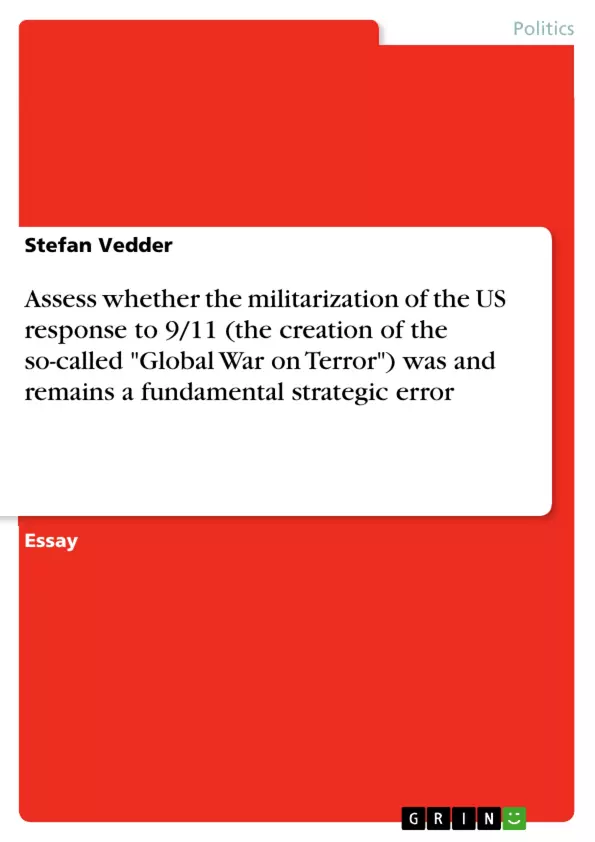In his address to the congress on 20.09.2001 George W. Bush described the terrorist attacks of September, 11 as “an act of war” and promptly proclaimed the “war on terror” with “a radical network of terrorists and every government that supports them” being the enemy. (Bush, 2001). In the subsequent years the United States have started wars in Afghanistan and Iraq that are today, eight respectively, roughly seven years later, not yet decisively won. The terrorists‟ capacity to execute devastating attacks has apparently not sustainably diminished given the numerous devastating attacks on US allies. At least the Bali (2002) and London (2005) bombings were directly attributed to Al Qaeda by President Obama (2009). The militarization of the US response to 9/11 has in several aspects proven not only to be inappropriate but even counterproductive in the struggle against international terrorism.
Inhaltsverzeichnis (Table of Contents)
- The US response to 9/11 and the “war on terror”
- The Impact of 9/11 on the US
- The military response in Afghanistan
- The shift of the terrorists’ safe haven from Afghanistan to Pakistan
- The success of the intervention in Afghanistan
- The US invasion of Iraq
- Justification of the invasion
- Outcomes of the invasion
- Consequences of the invasion
Zielsetzung und Themenschwerpunkte (Objectives and Key Themes)
This text examines the effectiveness of the US military response to the 9/11 attacks. It analyzes whether the "war on terror" strategy, characterized by the militarization of foreign policy, was a fundamental strategic error. The author assesses both the intervention in Afghanistan and the subsequent invasion of Iraq, comparing their intended objectives and actual outcomes.
- The strategic consequences of the “war on terror”
- The impact of US military intervention on the fight against terrorism
- The role of rogue states and failed states in terrorism
- The effectiveness of military force in combating terrorism
- The influence of US military intervention on public opinion in the Middle East
Zusammenfassung der Kapitel (Chapter Summaries)
- The US response to 9/11 and the “war on terror”
- The Impact of 9/11 on the US: This section examines the unprecedented nature of the 9/11 attacks and their impact on the US public, highlighting the demand for a decisive military response.
- The military response in Afghanistan: This section discusses the initial US military intervention in Afghanistan, focusing on the decision to employ Special Forces and air power rather than a full-scale invasion. It also analyzes the reasons for the US's inability to capture key Al Qaeda leaders.
- The shift of the terrorists’ safe haven from Afghanistan to Pakistan: This section describes the shift in the terrorists' safe haven from Afghanistan to Pakistan and its implications for US security, emphasizing the potential for terrorists to acquire weapons of mass destruction.
- The success of the intervention in Afghanistan: This section analyzes the successes and failures of the US intervention in Afghanistan, highlighting the reduction of terrorist training camps while acknowledging the ongoing threat posed by the Taliban.
- The US invasion of Iraq
- Justification of the invasion: This section examines the justifications presented for the US invasion of Iraq, focusing on the alleged presence of weapons of mass destruction and the potential for Iraq to provide them to terrorists.
- Outcomes of the invasion: This section analyzes the outcomes of the US invasion of Iraq, highlighting the emergence of a raging insurgency and a civil war-like situation.
- Consequences of the invasion: This section discusses the consequences of the US invasion of Iraq, focusing on the negative impact on public opinion in the Middle East and the Islamic World, and the potential for increased support for terrorist organizations.
Schlüsselwörter (Keywords)
The text focuses on key themes such as the "war on terror", the militarization of foreign policy, US military intervention, terrorism, rogue states, failed states, public opinion in the Middle East, and the relationship between the US and the Islamic world.
- Arbeit zitieren
- Stefan Vedder (Autor:in), 2009, Assess whether the militarization of the US response to 9/11 (the creation of the so-called "Global War on Terror") was and remains a fundamental strategic error, München, GRIN Verlag, https://www.grin.com/document/155837



